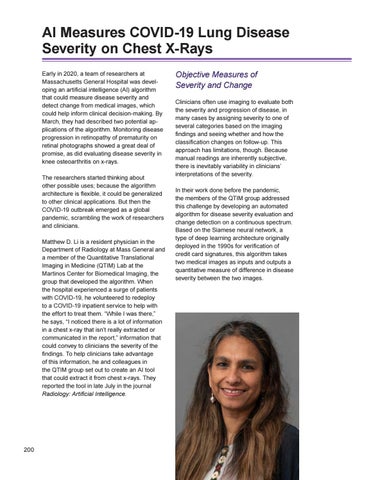AI Measures COVID-19 Lung Disease Severity on Chest X-Rays Early in 2020, a team of researchers at Massachusetts General Hospital was developing an artificial intelligence (AI) algorithm that could measure disease severity and detect change from medical images, which could help inform clinical decision-making. By March, they had described two potential applications of the algorithm. Monitoring disease progression in retinopathy of prematurity on retinal photographs showed a great deal of promise, as did evaluating disease severity in knee osteoarthritis on x-rays. The researchers started thinking about other possible uses; because the algorithm architecture is flexible, it could be generalized to other clinical applications. But then the COVID-19 outbreak emerged as a global pandemic, scrambling the work of researchers and clinicians. Matthew D. Li is a resident physician in the Department of Radiology at Mass General and a member of the Quantitative Translational Imaging in Medicine (QTIM) Lab at the Martinos Center for Biomedical Imaging, the group that developed the algorithm. When the hospital experienced a surge of patients with COVID-19, he volunteered to redeploy to a COVID-19 inpatient service to help with the effort to treat them. “While I was there,” he says, “I noticed there is a lot of information in a chest x-ray that isn’t really extracted or communicated in the report,” information that could convey to clinicians the severity of the findings. To help clinicians take advantage of this information, he and colleagues in the QTIM group set out to create an AI tool that could extract it from chest x-rays. They reported the tool in late July in the journal Radiology: Artificial Intelligence.
200
Objective Measures of Severity and Change Clinicians often use imaging to evaluate both the severity and progression of disease, in many cases by assigning severity to one of several categories based on the imaging findings and seeing whether and how the classification changes on follow-up. This approach has limitations, though. Because manual readings are inherently subjective, there is inevitably variability in clinicians’ interpretations of the severity. In their work done before the pandemic, the members of the QTIM group addressed this challenge by developing an automated algorithm for disease severity evaluation and change detection on a continuous spectrum. Based on the Siamese neural network, a type of deep learning architecture originally deployed in the 1990s for verification of credit card signatures, this algorithm takes two medical images as inputs and outputs a quantitative measure of difference in disease severity between the two images.
